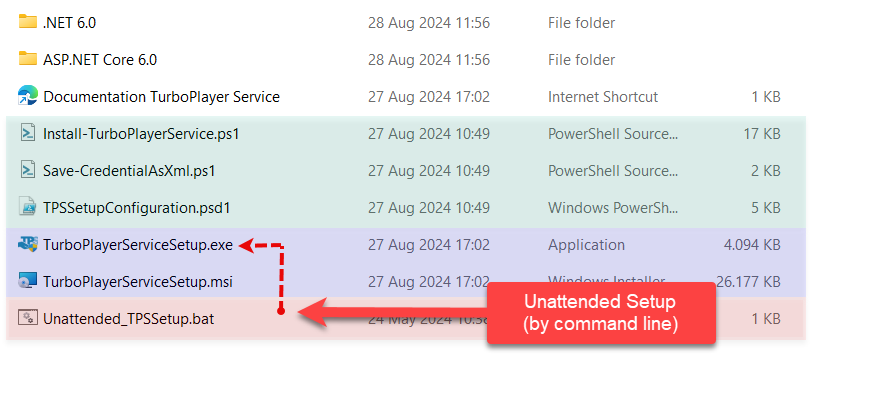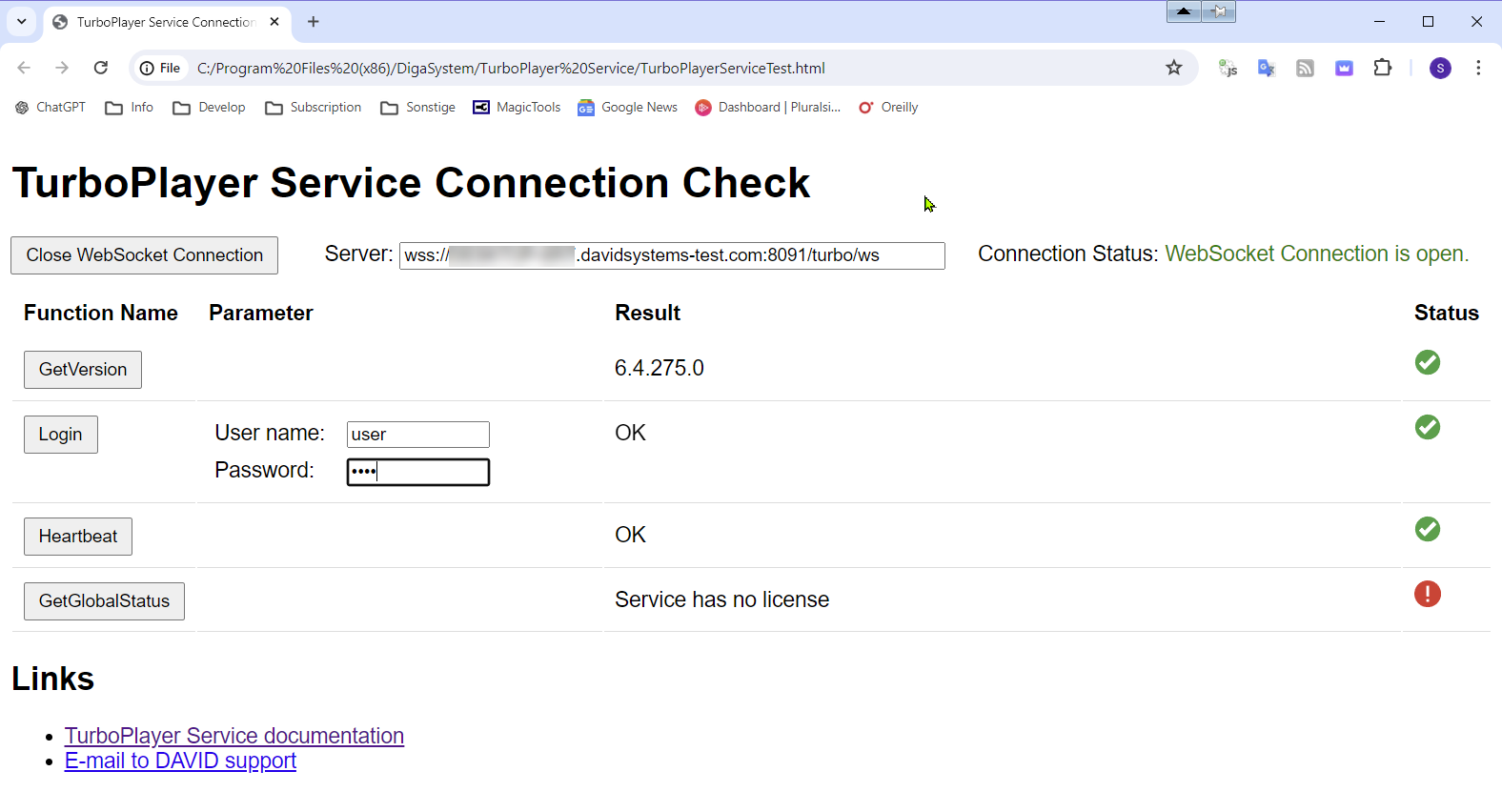Unattended TPS Setup (by command line)
This page describes the installation of TurboPlayer Service from the command line.
Usage scenario
First, the unattended installation via command line is ideal for installing on a local computer when all configuration parameters are known in advance.
Second, the command line installation is particularly useful for upgrade installations, where an older version of TurboPlayer Service is already installed and functioning.
Installation Procedure
Setup Folder
Unattended_TPSSetup.bat is an example batch file that can be used as a template for unattended setup via the command line.
TurboPlayerServiceSetup.exe, TurboPlayerServiceSetup.msi, the .Net 6.0 Runtimes (x86, x64) and the ASP .NET Core 6.0 Runtimes (x86, x64) are required for installing the TurboPlayer Service from the command line.
We recommend to copy the complete installation folder (
Setup) into a local directory, because access to mounted network drives may conflict with elevated privileges required during the installation process.

TurboPlayer Service Setup folder
Installation with a batch file
Open the file
Unattended_TPSSetup.batwith your favorite text editor (or Notepad)
BASH
|
Adjust at least
USER_NAME,
DOMAIN_NAME,
USER_PASSWORD,
DPE_URL,
DPE_USER,
DPE_PASSWORD,
CERTIFICATE_THUMBPRINT
DIGASYSTEM_COMPUTER_REGISTRY and
DIGASYSTEM_TURBOPLAYER_CONFIGURATION
with the appropriated values for your company. For a description of the setup properties see the https://davidsystems.atlassian.net/wiki/spaces/LTPS/pages/edit-v2/349077523#Setup-Properties below.
Save the new text file as
Unattended_TPSSetup.batin the folder whereTurboPlayerServiceSetup.exeis located.Open a command line window with elevated rights by press Windows+R, to open the Run dialog, type
cmdand press Ctrl+Shift+ENTER.Change the current directory to the path where
TurboPlayerServiceSetup.exeis located.Type
Unattended_TPSSetup.batto start the installation.
For an upgrade installation that requires no changes to the configuration, instead of a batch file simply use the command line
TurboPlayerServiceSetup.exe /L*V setup.log /qnAll configuration settings from the previous installation are preserved.
(The parameter /L*V setup.log directs the system to create a verbose log in the file named setup.log. The /qn parameter specifies that the installation should proceed without user interaction.)
If the installation was successful, the TurboPlayer Service is started.
TurboPlayer Service Connection Check
The installation directory contains a Connection Test HTML page (C:\Program Files (x86)\DigaSystem\TurboPlayer Service\TurboPlayerServiceTest.html ). Open the TurboPlayer Service Connection Check page by double-clicking on TurboPlayerServiceTest.html
Click Open WebSocket Connection button. The Connection Status should change to WebSocket Connection is open.
Click GetVersion button. The Result column should display the version number of the installed TurboPlayer service.
Enter a valid DigaSystem credentials (Username and Password) which has the required rights to monitor or control TurboPlayer.
Click Login. The Result column should display OK.
Click Heartbeat. The Result column should display OK.
Click GetGlobalStatus. If the Result column displays Service has not license, see License File

TurboPlayer Service Connection Check Test Page
Continue with the Post-installation requirements
Setup Properties
Properties are (among other) the data which the user would normally enter into the installer's GUI. Properties come as pairs of name and value. You can set properties for unattended setup on the command line by adding value=name pairs after all command line switches.
Property name | Explanation | Example | Type | Allowed values | Default value |
|---|---|---|---|---|---|
APPDIR | The directory where TurboPlayer Service is to be installed. | C:\TurboPlayerService\ | string | a valid folder | C:\Program Files (x86)\DigaSystem\TurboPlayer Service\ |
USER_NAME | The user name of the credentials under which the TP service should run | myname | string | (empty) | |
DOMAIN_NAME | The domain of the user name for the credentials under which the TP service should run | domainname | string | (empty) | |
USER_PASSWORD | The password of the credentials under which the TP service should run | mypassword | string | (empty) | |
START_TURBOPLAYER_SERVICE | Start service after installation. (empty) means START_TURBOPLAYER_SERVICE="" | (empty) | string | (empty), Checked | Checked |
DPE_URL | URL of DPE | http://dpehost | url | (empty) | |
DPE_USER | Name of DPE user. | dpeuser | string | (empty) | |
DPE_PASSWORD | Password of DPE user. | **** | string | (empty) | |
CONNECTION_USE_SECURE_PROTOCOLS | Specifies whether secure protocols (https/wss) or unsecure protocols (http/ws) should be used for the connection between a web client and TurboPlayer Service | SecureProtocols | string | UnsecureProtocols, SecureProtocols | UnsecureProtocols |
CERTIFICATE_THUMBPRINT | The thumbprint value of the SSL certificate. The thumbprint is only used if CONNECTION_USE_SECURE_PROTOCOLS is “SecureProtocols“ | 01234567890abcdef01234567890abcdef012345 | string | string that consists of 40 hexadecimal characters without spaces. | (empty) |
CONNECTION_DNS_NAME | The DNS name of the computer. The DNS name must match the Common Name (CN) of the SSL certificate which is specified by the thumbprint CERTIFICATE_THUMBPRINT. | myComputer.example.com | string | <URL> | (empty) |
CONNECTION_WEBSOCKET_PORT | The port number of the WebSocket connection. | 8091 | int | 1-65535 | 8091 |
DIGASYSTEM_CONFIGURATION | Name of TurboPlayer Service configuration | myTpsConfig | string | (empty) | |
DIGASYSTEM_COMPUTER_REGISTRY | Name of the computer where TurboPlayer engine is running and which TurboPlayer service should control. | tpHost | string | (empty) | |
DIGASYSTEM_TURBOPLAYER_CONFIGURATION | Name of an existing TurboPlayer configuration which specifies the connection properties to the TurboPlayer Engine. | TurboPlayer | string | (empty) | |
DIGASYSTEM_TURBOPLAYER_GUI_NUMBER | The number which specify the ports used to communicate between the GUI and the engine.
| 3 | int | 2 |
Note: Environment variables can be used e.g., "%ProgramFiles%\My TPS" would expand to "C:\Program Files\My TPS"
